The relationship between the NFL and the United States military exhibits a dynamic relationship engaging nationalism with discourses both positive and negative. This article will focus on the ingraining of said nationalism into the sport from an early age as well as highlight how it cultivates a uniquely American hegemonic identity that many latch onto. Additionally, we address some of the results; specifically, the sense of unity and in contrast, the blindsiding of politics and shallow glorification of the military.

As early as middle school but mainly in high school, youth are encouraged to try out for the football team and display their school pride. This eventually becomes national pride. In Figure A., the team is standing at attention, hands over their hearts, flags in hand, to the national anthem. This ritual of standing at attention is done at every single football game whether it be at a scrimmage or large playoffs –it is traditional and mandatory. Young athletes in this position do not have the agency to defy this tradition. Many do it without question, thus kickstarting a long line of national traditions in this sport. This is the start of the normalization of national pride in sports. Football takes a “powerful…substantial role in shaping popular understandings of…social identities” like patriotism (Duda 2011). Thus, from an early age, ideas of nationalism are shaped by these football traditions. Let it be known that we are separating nationalist pride that develops through other means such as morning anthems in school and classes. We are focusing on how the sport of football cultivates it specifically. A big difference is the associated imagery. In football games, it becomes much more obvious. Eventually this leads to much more grandiose displays of the national pride.
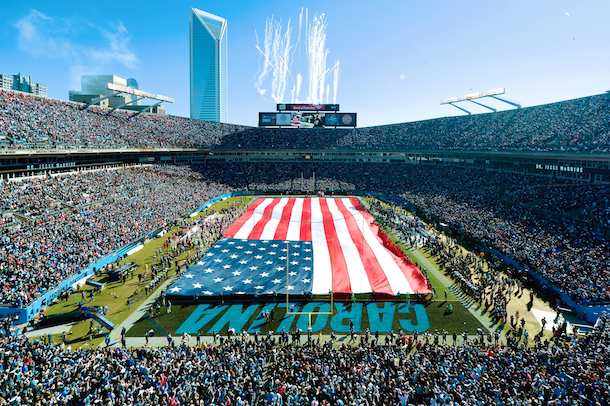
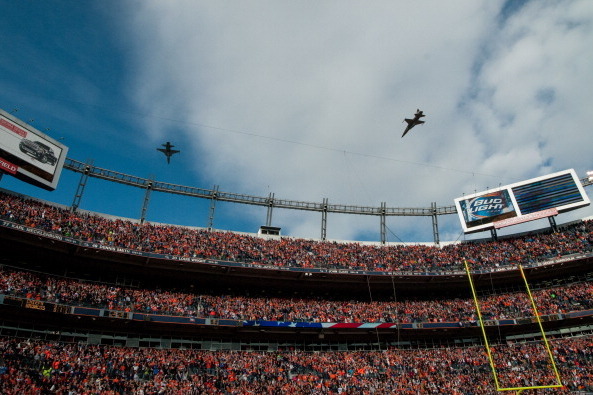
When it comes to national or military imagery, professional football does it big. We equate how much we love our country with very big (and most likely expensive) displays of our pride. Imagery and pride grows with time: as visibility increases, so too does American nationalism. We are going from lining up on a small field to F-18s soaring above to mark our strength and prove how dedicated we are to our country (Figure B-C). This works in the sense that football fans have a shared sense of identity – whether it’s in relation to the high school football star turned college player turned NFL Quarterback star. This shared identity is the core of what football means to Americans and their national identity. In fact, we pride ourselves on being “uniquely American” through this.
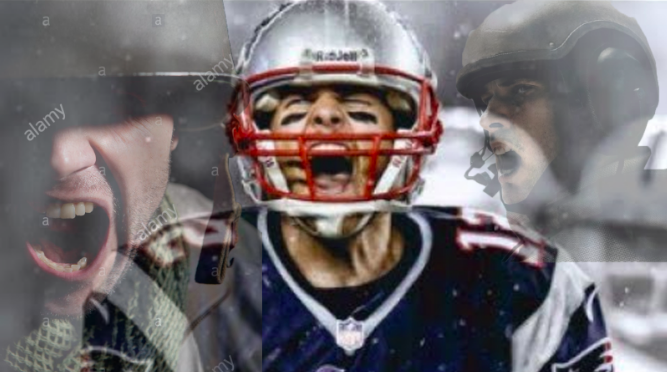 American Warriors (Figure D) (Composite Image: 1, 2, 3)
American Warriors (Figure D) (Composite Image: 1, 2, 3)
No other sport can be so singularly associated with an individual country. Football “resonates across a US audience” that uses “patriotism as [a signifier] of authentic American citizenship” (Leonard 2016). Americans strive to separate themselves from other sports fans, especially from that “lowly” soccer game, and be a part of the lifestyle so to speak. And with the nationalism frame of mind, football is indeed more of a lifestyle or cultural identity rather than “just a game.” (Figure D). Football is an American sport. While baseball may have began here, it is now a global phenomenon. Basketball too has seeped down into Latin America, China, and Spain to become a broader contextual sport (Schottey, 2014). American Football, however, with its own set of rules, has stayed ‘true’ to its roots. Massive amounts of money and attention go towards making football important and vital in American lifestyle. The Super Bowl is a perfect example of how much this sports matters in terms of defining a very American event. This event is a beacon of the importance of football to its fans and the kind of widespread visibility it has.
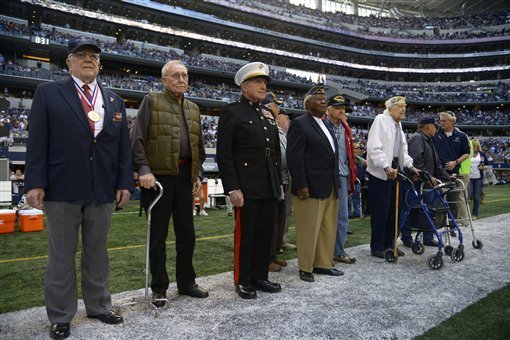
Veterans Remembered and Honored (Figure F)
In general, visibility for everything increases as one approaches the professional rank. This comes in particular as a benefit to US veterans. Visibility for them is highlighted at games and is often focused on during events. Because of the massive platform that exists in the NFL (a large reason many companies are eager to have their ads on during games, specifically for the Super Bowl), the stage is set for the hyper-visibility of military and its personnel. Since the imagery of nationalism in games is already very potent and normalized, military personnel doing coin tosses or being honored is no coincidence or out of the ordinary (Figure E-F). Aside from the players themselves, military personnel are the stars of events they are honored at, whether at a local or national level. This causes immediate focus and attention to veterans and their service. Football fans are constantly reminded about the service and sacrifice of veterans old and new. There is always a spotlight on veterans and the role they play in nationalism. This in turn creates a massive and almost universal support and appreciation for them. This also heavily contributes to the overall unity and pride that is associated with the sport. Moreover, there are actually a few programs such as the United Service Organizations (USO) known for supporting troops overseas and helping connect them to their lives back home as well as the Wounded Warriors Project which the NFL contributes funding to.
Where do we draw the line that separates the U.S. military and the NFL? It becomes increasingly hard to tell the difference when the militarized demonstrations going into every NFL broadcast and the war terminology that exudes from the very core of the game is so prominent. This of course has helped the NFL and its partners as besides being good for business, a general feeling of patriotism to support our troops develops. In contrast to this though, these mentioned demonstrations prioritize a more amiable sense of the military. Overshadowing actual war, violence, or hopelessness troops may feel. Instead we have vibrant fireworks, jets flying by, and enormous drum marches or flag displays. The NFL has becomes the standard for what many experience as patriotism. To be clear, when all that fans see are F-18s roaring above and soldiers in their alpha dress with all limbs intact, it isn’t an accurate portrayal of the military (Schottey, 2014). The issues veterans face today include suicide, marital problems, and unemployment – many while still in the military. These issues are not represented in the patriotic demonstrations yet they are often the real problems experienced.
While the hypervisibility that the NFL provides for national pride, imagery, and military serves to unite masses of people into a similar American identity, these grandiose displays of imagery may also serve to blindside people of any critiques of the hegemonic ideals of America (Figure G). Colin Kaepernick, an NFL player, began a protest in support of Black Lives Matter by kneeling during the national anthem at games. The backlash was immediate and incredible.Even though Kaepernick explicitly stated why he was protesting, many football fans equated his actions as blatant disrespect for the country, its morals and the military.The narrative of anti-america was repeated again and again by football fans and news critics. Kaepernick was protesting the issue of police brutality systematically targeting black youth in America. He was crucified for critiquing the very country his sport is meant to glorify. Even though critics recognized his intentions, many felt that disrupting a national tradition was taking things too far because it disrupted the hegemonic American identity his role is meant to enforce.
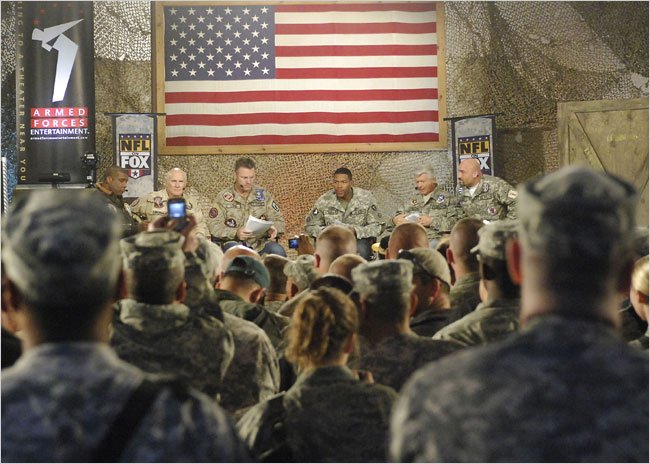
Fox NFL Sunday in Afghanistan (Figure H)
There was a seemingly normal broadcast back in 2009 – or what many understood as just another special to prepare for veterans day. In reality however, it was a program that technically glorified fake warriors and their game to a group of actual warriors engaged in an 8-year conflict (Genzlinger, 2009). “Fox NFL Sunday” flew to Afghanistan in advance of Veterans Day to commemorate soldiers and patriotism while also promoting football (Figure H). The show was chock-full of mutual back scratching in the sense that, Fox and the NFL intended to establish themselves as the most fervent supports of the troops while the military focused on steering the Fox crew to showcase clips that didn’t feature blood or any images of moral ambiguity. Furthermore, there was a clip bringing attention to NFL players and employees who had served in the military at some point as well as any currently serving relatives and coaches. The promotions in between featured both football and military images wrapped around words such as “teamwork, leadership, courage.” They of course, showcase peaceful clips such as when American soldiers are advising an Afghan local village about agriculture and some training regimens. They eventually move on to cover Pat Tillman – the NFL. player who previously left football to enlist back in 2004. Tillman, it was soon discovered, did not support the reasoning of the conflict in the middle east. The broadcast failed to mention this. Nor was his death – being killed in a friendly fire incident elaborated on. In fact, it was glossed over entirely. Instead, quickly replaced by festivities surrounding the Tillman memorial with U.S.O. (Genzlinger, 2009). To be frank, the show gave the illusion that war and football are the same despite incredible differences between stakes, rules, etc.. It blurred the lines to the point of insanity. Viewers accepted the broadcast and the ‘clean images of military as reality. The whole event reinforces the idea that we are blindsided by the politics of American nationalism.
To recap, the alliance between the NFL and the military has created a severe sense of nationalism that comes with both benefits and toxic consequences. Ultimately, by focusing so much of our time and energy into the discourses surrounding football and highlighting the importance of the game in schools early on, Americans are proclaiming a shared cultural identity that has become synonymous with patriotism. As made clear, this brings some good with the increased visibility towards veterans but it also undermines the stakes and politics inherent of a country’s military.
References
Duda, E. J. (2011). Ports and the city : the rhetorical construction of civic identity through American football teams. Austin, TX: University of Texas.
Genzlinger, N. (2009, November 08). Gridiron Gladiators: Block That Metaphor! Retrieved March 04, 2018, from http://www.nytimes.com/2009/11/09/arts/television/09fox.html
Jones, J. (2017, March 24). Colin Kaepernick Is To The NFL What Black People Are To America. Retrieved March 04, 2018, from https://www.huffingtonpost.com/entry/colin-kaepernick-is-to-the-nfl-what-black-people-are-to-a
Leonard, D. J., George, K. B., & Davis, W. (Eds.). (2016). Football, culture and power. Retrieved from https://ebookcentral-proquest-com.ezproxy.lib.utexas.edu
Owens, D. S. (2017, November 28). One Psychologist’s Perspective on Why Politics Have No Place in Sports. Retrieved March 04, 2018, from http://www.shrinktank.com/why-politics-have-no-place-in-sports/
Schottey, M. (2017, April 09). The Flag and the Shield: The Long Alliance Between the NFL and US Military. Retrieved March 04, 2018, from http://bleacherreport.com/articles/2029052-the-flag-and-the-shield-the-long-alliance-between-the-nfl-and-the-us-military
